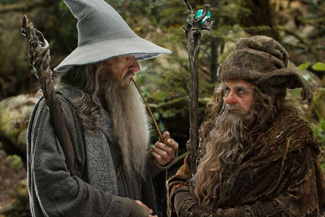Top 12 Film Industry Stories of 2012: #5
The Hobbit Leaves the Shire Once Again
By David Mumpower
January 7, 2013
From 2005 until the end of 2007, there was little progress made with regards to pre-production of The Hobbit or Peter Jackson’s wallet. New Line Cinema acted aggrieved by Jackson’s “piggishness”. They maintained that he had been paid roughly $200 million already. Asking for another $100 million seemed petty and ungrateful. Conversely, he felt that if he was owed another $100 million, he should not be nickel and dimed by a studio who had earned over $4 billion in revenue (only some of it box office) from The Lord of the Rings movies.
In December of 2007, the feud ended rather anticlimactically. Jackson and his business partner agreed to produce another two Middle Earth movies, although he stated no intention to direct. In exchange, New Line Cinema presumably gave the vaunted filmmaker enough cash to buy Australia and rename it New New Zealand.
All that remained was to produce some movies. This task proved easier said than done. Jackson’s friend and confidante, Guillermo del Toro, was initially chosen to helm the project. Over time, he grew frustrated by his inability to put his own stamp on what would inevitably be remembered as Jackson’s franchise. In 2010, del Toro politely dropped out of The Hobbit with Jackson ceding to the demands of the free world. He agreed to direct The Hobbit.
In the process, Jackson also announced an intention to turn the 320 page book into a movie trilogy. Film fanatics were a bit befuddled by this. Most of them understood that J.K. Rowling’s Harry Potter and the Deathly Hallows contained 784 pages. In order to tell the story correctly, it had to be split into two films. Similarly, Stephenie Meyer’s final Twilight novel, Breaking Dawn, was 756 pages. There was justification for it to be split into two movies as well. When Suzanne Collins’ Mockingjay, a 390 page novel, became a two film endeavor, consumers were ready to throw their hands in the air. Finally, the always reliable Peter Jackson decided that he could create three movies out of 320 pages. This is the moment when consumers began to lose a bit of faith in The Hobbit.
Theater owners quickly followed in this regard. In April of 2012, the first footage of The Hobbit aired at CinemaCon, a seminal exhibitor event held annually. It was here that Jackson displayed his usage of a new technology. The Hobbit trilogy was filmed using cameras that capture images at 48 frames per second, double the cinema industry standard for many decades now. The stated intent was to provide an enriched viewing experience to consumers.
Alas, exhibitor reception was icy. The consensus was the photo-real imagery was in fact too realistic. Feature films are expected to possess a certain visual style. At 48 frames per second, the clarity was such that many projectionists stated the belief that this meticulously cultivated façade was ruined. The end result was not a more pleasurable viewing experience but instead a made for television movie of the week vibe instead. How could an exhibitor ask a consumer to pay exorbitant 3D ticket pricing for that? The matter is still up for debate. Overall reception to the new video format is decidedly mixed.
Worst of all, the new video format is not the only word-of-mouth that is decidedly mixed. When reviews appeared on aggregator sites such as Rotten Tomatoes, fanboy hearts were broken. The three films comprising the Lord of the Rings trilogy possessed scores of 92, 96 and 94. The Hobbit managed only 65%. And if we filter the results to include Top Critics, the news is grim. The Fellowship of the Ring earned 92% while The Return of the King was even better at 98%. The Two Towers remains 100% fresh among Top Critics to this day. What is The Hobbit’s score among Top Critics? 42%. Ouch.
Perhaps the movie’s moderate box office is unsurprising due to all of the above. Despite nine-to-11 years of box office inflation working in its favor, The Hobbit’s opening weekend of $84.6 million was not significantly beyond the $72.6 million debut of The Return of the King. After 24 days in theaters, its running domestic total of $263.8 million trails The Two Towers’ $272.5 million and is 13% short of The Return of the King’s $301.7 million.
The juvenile tone of the title combined with mediocre buzz mentioned above has proven problematic. Even worse, the unrealistic expectations of its fans have led to lackluster word-of-mouth. As unbelievable as this is to write, The Hobbit is something of a commercial disappointment, at least domestically. The first film in the already-filmed trilogy has already grossed $825 million worldwide and appears to be a lock to become the second Middle Earth movie to cross the billion down mark in global box office. Still, there is an issue of opportunity cost in terms of unattained revenue. Fans expected more from Peter Jackson; instead, The Hobbit feels like less than its predecessors.
Whether you agree or disagree with the above, there is no disputing the fact that The Hobbit has been a primary source of conversation the entire year. Starting with the debut of the new 48 frames per second film style, fans have breathlessly anticipated the release of the fourth Peter Jackson Middle Earth film. While its debut has been marked by unexpected criticism, Jackson still has two more films to prove that his ideas are good ones. After all, The Fellowship of the Ring is the worst performer of the Lord of the Rings trilogy as well.
Continued:
1
2




